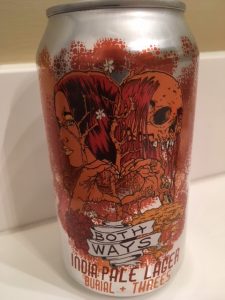Music can be both jazzy and classical; beers can be part ale and part lager. This article introduces brewers and composers who have it both ways.
THE BEER:
Both Ways by Burial Beer Co. and Threes Brewing
Beers traditionally fall into one of two categories, ales or lagers, which use different types of yeast. Ale yeasts ferment at higher temperatures and often create fruity flavors. Lager yeasts prefer colder temperatures and lead to crisper tastes.
Last year Asheville-based Burial Beer Co. and Brooklyn-based Threes Brewing joined forces to make a beer that was both an ale and a lager. The resulting Both Ways India pale lager (“IPL”) landed a spot on DRAFT magazine’s list of the top 25 beers of 2017.

Both Ways somehow manages to highlight the best of both ales and lagers. DRAFT magazine describes how the “lemon juice” aroma of many ales and the “saltine crackers” of lager mingle in the beer’s bouquet. It also notes how the beer’s fruity “peach, pineapple and orange-pulp” flavors mix with the crisp taste of “dried grass.” For more information on the IPL style Both Ways exemplifies, check out another DRAFT article, “What the Hell’s an IPL?”
Lagers are sort of like classical music. They first appeared in Europe in the 15th or 16th century and eventually spread across the globe. And, at least in their eclecticism, ales are more like jazz. Just as jazz musicians incorporate everything from Indian percussion to British poetry into their music, adventurous brewers use everything from oysters to tomatoes to make ales.
THE MUSIC:
George Gershwin
Although lager and ale blends are new, composers have been mixing jazz and classical music for almost a century. Pioneers in this combination approached the styles with different goals. Some wanted to bring more jazz into the orchestra. Others wanted to bring more orchestra into jazz.
George Gershwin was famous for bringing jazz into the orchestra. In 1924, bandleader Paul Whiteman commissioned Gershwin to write a piece for jazz band in the style of a solo concerto. That piece, Rhapsody in Blue, cemented Gershwin’s status as a master of classical and jazzy idioms and led to further jazz/classical pieces such as the Concerto in F. Although a jazz band premired the Gershwin Rhapsody, classical orchestras often play the piece today in an arrangement by Ferde Grofé.
Duke Ellington
While Gershwin was bringing jazz into the orchestra, Duke Ellington was trying to bring the orchestra into jazz. Ellington’s pieces displayed moods and instrumental colors that had never appeared in jazz. Ellington even jazzed up orchestral favorites such as Grieg’s Peer Gynt Suite.
During his life, Ellington struggled, sometimes unsuccessfully, to be revered as a “serious” composer. Today the conservative critics who disparaged Ellington’s music look silly. Ellington’s output is one of the most significant bodies of musical work of the twentieth century.
Maria Schneider
No modern composer is more adept with both jazz and classical music than Maria Schneider. She has won GRAMMY awards in both jazz and classical genres, and she has written pieces for both the St. Paul Chamber Orchestra and Jazz at Lincoln Center.
Schneider’s orchestra includes instruments that rarely appear in jazz, including alto clarinet and accordion. And Schneider’s compositions are often more atmospheric than traditional jazz fare. But they also make space for the virtuosic solo improvisation that is the hallmark of traditional jazz. Schneider, like Burial and Threes, truly lets her fans have it both ways.
Today jazz groups around the country play Schneider’s music. Here’s the jazz ensemble of Whitworth University playing Schneider’s “Walking by Flashlight.” We think this track goes well with an IPL. But, please, if you ever decide to actually go walking by flashlight, leave the alcohol at home.